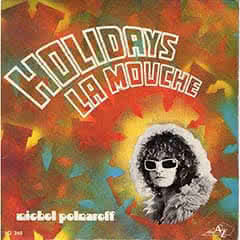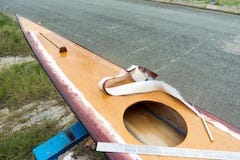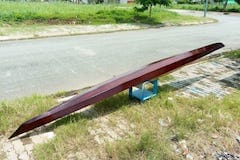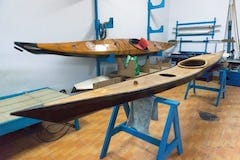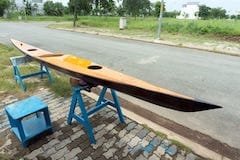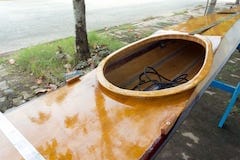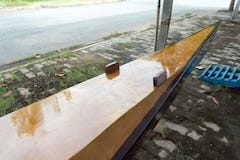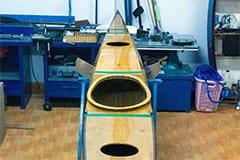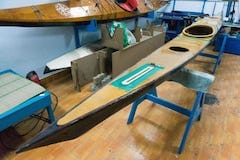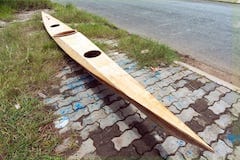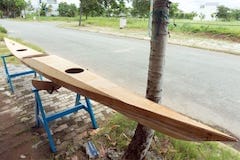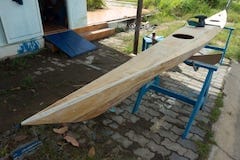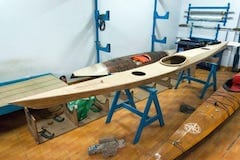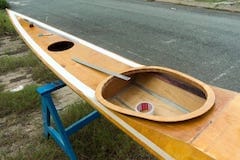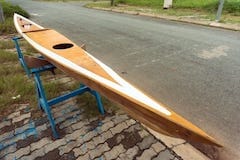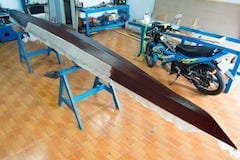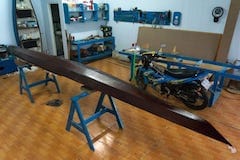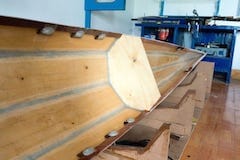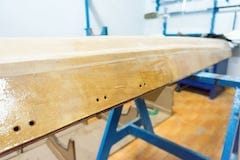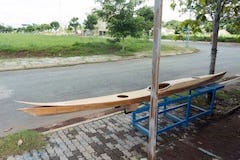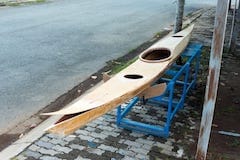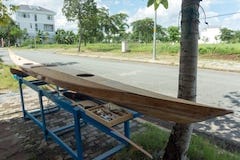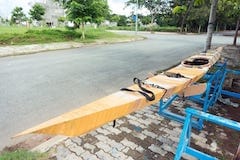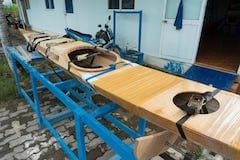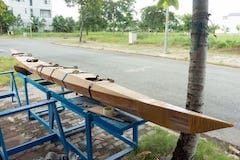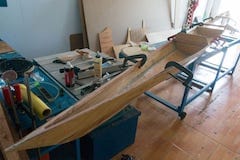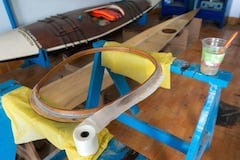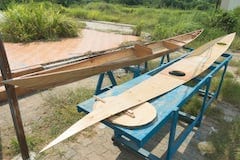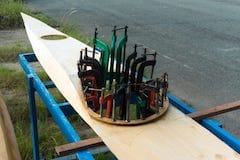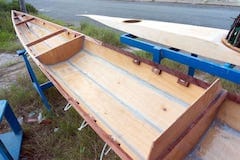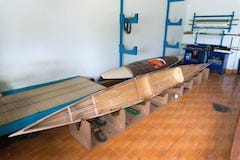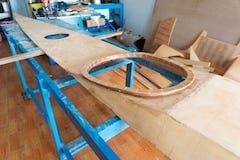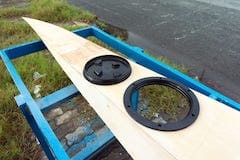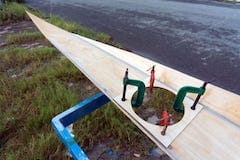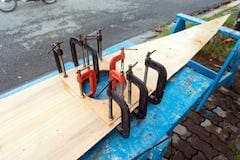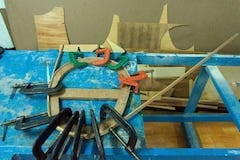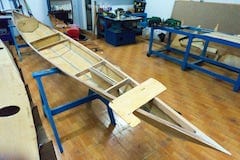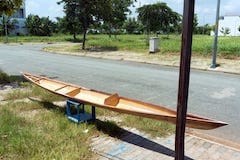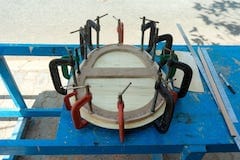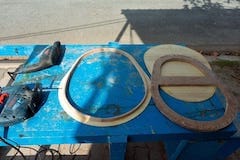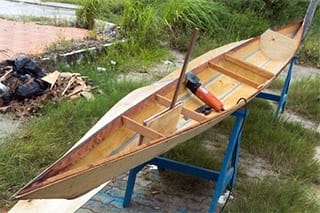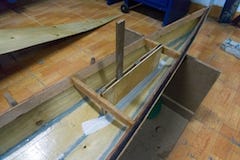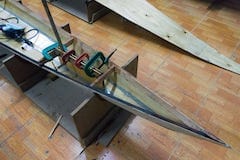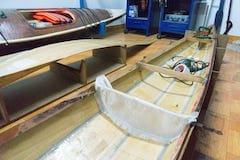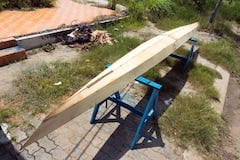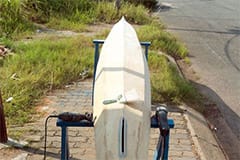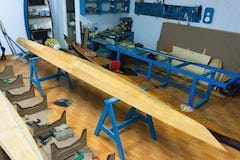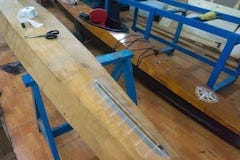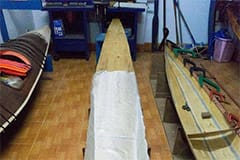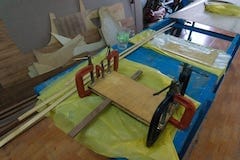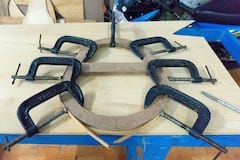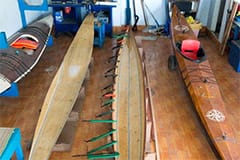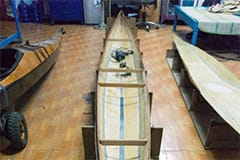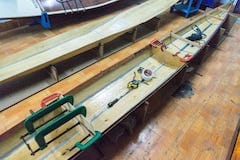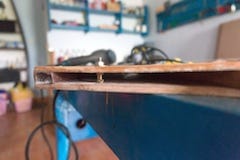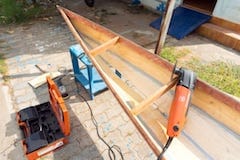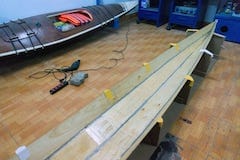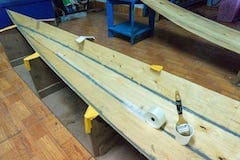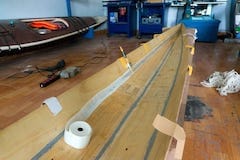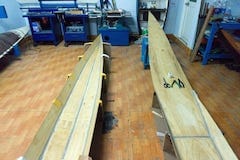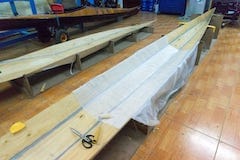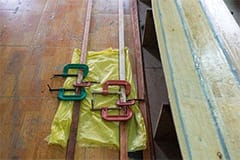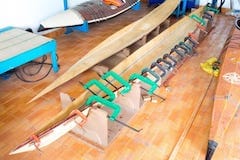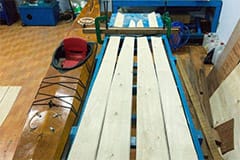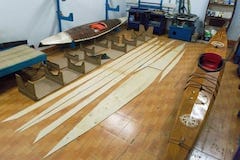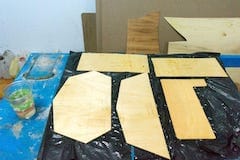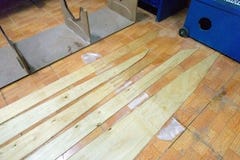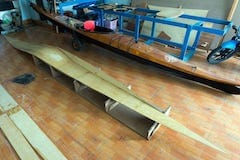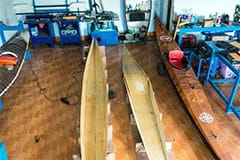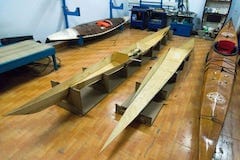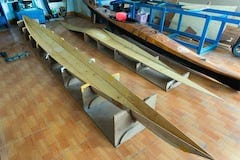 ne autre vieille chanson Française de temps en temps, j’aime particulièrement des percusions, et aussi de guitar, dans un tempo très modéré…
ne autre vieille chanson Française de temps en temps, j’aime particulièrement des percusions, et aussi de guitar, dans un tempo très modéré… La mer comme une preface, avant le desert, que la mer est basse, holidays! Tant de ciel et tant de nuages, tu ne sais pas a ton age, toi que la vie lasse, que la mort est basse, holidays!
serene – 1, part 15
 pply a very thin epoxy fill – coat to completely cover the fiberglass fabric weaves, then peel off the duct tapes (together with the excess glass) with a sharp knife. The hull is then exposed to sunlight for the epoxy to completely cure, before given a very light sanding in prepare for painting. I paused for a few moments to watch her lines, well, with the singular exception of the “man – of – war”, all boats is always referred to as “she / her”, there must have been a reason for that, right!? 😀
pply a very thin epoxy fill – coat to completely cover the fiberglass fabric weaves, then peel off the duct tapes (together with the excess glass) with a sharp knife. The hull is then exposed to sunlight for the epoxy to completely cure, before given a very light sanding in prepare for painting. I paused for a few moments to watch her lines, well, with the singular exception of the “man – of – war”, all boats is always referred to as “she / her”, there must have been a reason for that, right!? 😀
Next come the job of installing some miscellaneous deck hardwares, the deck plate to seal off the skeg box, two small wood blocks acting like tiny cleats to hold the skeg control line… Some more unnamed works needed before the deck could be painted. You can also notice from the images that the deck has received another layer of thinned epoxy (mixed with color pigment). I was thinking over about the color scheme, but found out that it’s best to just have wooden colors on a boat.
7th, 8th images: using duct tapes to mask the areas out for painting. The cockpit would be painted first in dark brown color, like the hull, as well as some other parts on deck. After some simplest decorations go in, the deck and hull would be coated with transparent PU, just one layer on top and two at the bottom. After that is the final fitting (hatches, lashing lines, skeg control) and the boat would be ready for water, seems like I can’t wait anymore for it, to try out the boat this weekend! 😀
Serene – 1 p1
Serene – 1 p2
Serene – 1 p3
Serene – 1 p4
A bit off topic about the connotation of concepts… (in addition to polyurethane vs PU in the previous post) in Vietnamese the terms: áo ấm (warm jacket) and áo lạnh (cold jacket) vaguely refer to one same thing. In English, a wet suit and a dry suit are two different things! 😬
Reflected by the language, the Vietnamese are usually narrow – minded, they don’t take concepts into the very detailed, they don’t see things from different angles. They only see what’s immediately closed to them. As such, they’re easily tricked into seeing only what they / others want to see!
serene – 1, part 14
 ome tweaks here and there to smoothen the jointing edges between the hull and deck, putty – seal the bulkheads to the deck, then some slight overall fairing and sanding before putting on the final layer of fiberglass to the bottom part. The glass will marginally wrap over the deck (about 1 inch of overlapping) to strengthen and completely seal the joint. Deck would have no fiberglass on the external side, and would only be clear – coated with thinned epoxy and polyurethane (PU) paint.
ome tweaks here and there to smoothen the jointing edges between the hull and deck, putty – seal the bulkheads to the deck, then some slight overall fairing and sanding before putting on the final layer of fiberglass to the bottom part. The glass will marginally wrap over the deck (about 1 inch of overlapping) to strengthen and completely seal the joint. Deck would have no fiberglass on the external side, and would only be clear – coated with thinned epoxy and polyurethane (PU) paint.
4th image below: the deck thoroughly sanded with 100 grit paper, it looks quite fine now! In my previous boats, I was usually over sanding, with multiple grit – levels applied, and lots of efforts too. But now, I’d realized that I actually don’t need a furniture – grade finish (and I couldn’t do it as nice as a professional woodworker nevertheless). After all, a boat is a functional (not a show – case) object with lots of hard and harsh uses. A too perfect finish wouldn’t be of any practical good!
5th image: the deck has been stained with thinned epoxy mixed with color pigment (yellowish wooden color). The white duct tapes mark the area of wrapping when glassing the bottom. 6th, 7th images: glassing the hull exterior and wrap the fiberglass an inch over the deck. I used exactly 300 gram of epoxy mixed with dark brown wooden color pigment. A lesson learnt from the previous boat: use lighter colors for the wood to appear natural, too strong, deep colors look very… ‘artificial’.
Serene – 1 p1
Serene – 1 p2
Serene – 1 p3
Serene – 1 p4
About polyurethane (PU) paint: it’s a broad category of paint with different sub – types and applications, but in Vietnam, the term is narrowly and misleadingly meant to be one used for (semi – clear color) wood – surface finish only, as people is only familiar with that widespread use.
So if you want to see other types of the paint, say: Polyurethane, don’t say PU 😬! As the vendors will assume you know nothing about it, and by telling the chemical formula, you would be given more choices, don’t say PU, or you would be wrongly given the interior / inferior furniture finish!
serene – 1, part 13
 arved and installed two wood blocks at the two ends to drill holes for the pulling knots (to further save weight, I won’t pour epoxy into the two tips, just the wood blocks with some sealing putty), sanding the cockpit coaming, glassing the lashing lines’ anchor points built into the hull, some more miscellaneous jobs before I can dry – fitting the hull and deck together. In the next couple of days, we’ll see the boat in its final shape! First two images below: inside and outside of the anchor points.
arved and installed two wood blocks at the two ends to drill holes for the pulling knots (to further save weight, I won’t pour epoxy into the two tips, just the wood blocks with some sealing putty), sanding the cockpit coaming, glassing the lashing lines’ anchor points built into the hull, some more miscellaneous jobs before I can dry – fitting the hull and deck together. In the next couple of days, we’ll see the boat in its final shape! First two images below: inside and outside of the anchor points.
Cut a slot in the aft deck for the skeg box to get through, then the hull and deck are ready to be jointed together, with just some epoxy (not putty) applied to the edges. The two ends, bow and stern, fit well, I just need duct tapes to press them together. The mid section requires some fastening as the plywood bent and and does not offer a perfect match. Nevertheless, the overall process is smoother compared to my previous boats, and I’m so happy to see the kayak taking on the designed shape!
I spent times going around and around the boat, watching the fruit of my efforts 😀! The hull shape looks very fine to me, the deck shape is quite crude indeed (not as cursive and fine as that of Hello World – 3, since the deck was drawn to be easy to build). But in essence, the lines, size, weight… all gives me a very comfortable and manageable feeling! Just a few more weeks from now and the kayak would be ready for her new life on water, can’t wait any more for that! 😀
Serene – 1 p1
Serene – 1 p2
Serene – 1 p3
Serene – 1 p4
With a flat deck, the kayak wouldn’t be particularly easy to roll, as once ‘turtled’, the deck becomes the bottom, and flat bottom is quite stable and difficult to turn over. So rolling is not a strong point of this design apparently, nor I did had rolling intention in mind!
Admittedly, I haven’t learned and practiced the Eskimo rolling techniques, and I couldn’t do it whatsoever, since my previous boats are too big and too heavy for me to roll. The techniques are in my (long – term) TODO list anyhow, at some points, I will try to master them!
serene – 1, part 12
 onitnue working on the deck part and the cockpit. But first… some pictures to show off the boat shapes, still quite a long way to the final forms, but look fascinating enough to me already, to quote a popular architectural saying:
onitnue working on the deck part and the cockpit. But first… some pictures to show off the boat shapes, still quite a long way to the final forms, but look fascinating enough to me already, to quote a popular architectural saying: form, IT IS function
😀! 3rd image below: the cockpit coaming being reinforced with some putty in the corner, then a layer of fiberglass tape the under side. 5th image: cockpit being jointed to the deck. There’re some miscellaneous jobs to be done on the hull still.
15 anchor points to be built into the hull. First, I glued small wood blocks alongside the gunwales, then drilled two holes (1 inch apart) into each block. Plastic lines 5 mm in diameter (the one usually used in fishery net) are run through, then putty is filled in, this way, just a small amount of putty is used. When the epoxy has cured, pull the lines out, you would have some “tunnels” to run the lashing through. Finally, small pieces of glass would cover and strengthen the wood blocks.
The cockpit coaming is glued, then glassed with the deck, two layers of fiberglass (one under and one upper), it’s very strong now, can withstand the weight of my whole body (while climbing onto it). For such a narrow kayak and small cockpit (45 cm in width, less internally), I don’t install any foot brace or thigh brace, and even back rest, the cockpit almost fits my lower body. I have no idea for a seat for now, maybe that I would just sit on the bare bottom, or with a thin layer of mattress.
Serene – 1 p1
Serene – 1 p2
Serene – 1 p3
Serene – 1 p4
[13 ~ 18] kg is the usual weight range of wooden kayaks, with the lighter being used for tourings, and the heavier as “expedition boats”. Plastic or FRP (fiberglass – reinforced plastic) boats are much heavier, often in the [25 ~ 30] kg range. In order to go below 12 kg…
…you would need a SOF (Skin on Frame) design, or make use of the expensive carbon, kevlar fibers (usually found in racing boats). So wood is a very ideal choice for kayaks (as well as any small watercraft), and I would be very happy to have mine aimed at the 17 ~ 18 kg target.
serene – 1, part 11
 ost major tasks on the hull has been completed, now continue on the deck part. First is cutting out the fore and aft hatches’ holes and fit some reinforcement rims (the plywood is weak, it can deform badly around the hatches in the long run). The Beckson hatches are quite small indeed, the largest are 8″ in internal diameter, have to live with that for now anyhow since Beckson does not have a larger size. I also made a rough fairing on the external side of the deck. Next comes the cockpit.
ost major tasks on the hull has been completed, now continue on the deck part. First is cutting out the fore and aft hatches’ holes and fit some reinforcement rims (the plywood is weak, it can deform badly around the hatches in the long run). The Beckson hatches are quite small indeed, the largest are 8″ in internal diameter, have to live with that for now anyhow since Beckson does not have a larger size. I also made a rough fairing on the external side of the deck. Next comes the cockpit.
The plywood is so fragile and easy to crack, so I turned to using wood for building the cockpit coaming. 2 thin strips of wood is combined to form the cockpit coaming riser. The strips are cut 3 mm thick and easy enough to bend without steaming, just use the C – clamps to force them following the cockpit template. The riser is quite high, 2 cm, and would be jointed with the plywood coaming lip 3 cm in width, all would be reinforced with some putty and fiberglass before jointing to the deck.
Using the angle grinder, I adjusted the bevel edges of the gunwales to better match the hull and deck. Also glassed the 3 hull’s external seams, each with about 80 gram of epoxy (240 gram in total). With experiences gained by now, I can control the amount of material used quite precisely. Hence, this gonna be the first boat which I could have weight truly under control, my projection is somewhere around 17 ~ 18 kg overall (everything not including the paddle). Let just see if I could make it there!
Serene – 1 p1
Serene – 1 p2
Serene – 1 p3
Serene – 1 p4
The Beckson hatches come with rubber o – rings that make the water – tight sealing. I made a mistake using some petroleum – based grease as lubricant on the rings, which could degrade and wear out the rubber. Have to clean it out and use some silicone – based grease instead.
One more ugly thing working with epoxy is that I usually need to mix them in a very small batches, just 30 ~ 40 gram or so (using an electronic scale). It seems counter intuitive, but the smaller the batch, the harder you would need to stir in order to have them mixed thoroughly.
serene – 1, part 10
 oat building is a labour – intensive process, and only skills and experiences could help to reduce workload and improve quality. Up until now, I’m quite pleased with the building, my 4th one. Today, I cut a slot into the aft hull to install the skeg box, the excellent Fein multimaster oscillating tool offers a nice cut as usual. Things went on smoothly, I have great confidence in this 5 cm fiberglass tape, it produces very fine and strong seam lines, so I decided to use just 2 layers (one inside, one outside).
oat building is a labour – intensive process, and only skills and experiences could help to reduce workload and improve quality. Up until now, I’m quite pleased with the building, my 4th one. Today, I cut a slot into the aft hull to install the skeg box, the excellent Fein multimaster oscillating tool offers a nice cut as usual. Things went on smoothly, I have great confidence in this 5 cm fiberglass tape, it produces very fine and strong seam lines, so I decided to use just 2 layers (one inside, one outside).
In my previous boat, I used 4 layers of fiberglass to secure the skeg box in place (which results into more weight added). The skeg blade is smaller, 30 x 14 cm, I guess a deeper V – bottom would track easier, so I would need a smaller blade just for some weather cocking conditions. Still stay indecisive about skeg’s control, I’m not totally happy with HW – 3‘s skeg control line, which runs over the aft deck, though perfectly functional, potentially could interfere with self – rescue actions.
Working on the skeg box vs. hull joint (the external side), then give the bottom a rough fairing to remove excess putty and smoothen out the edges, then apply 300 gram of thinned epoxy to it. A long busy day with lots of dust. Next would be exposing the hull to sunlight for 1, 2 days for the xylene solvent to completely vaporize, before glassing the external seams and other jobs. The hull part would receive an additonal overall layer of fiberglass once it’s jointed with the deck part.
Serene – 1 p1
Serene – 1 p2
Serene – 1 p3
Serene – 1 p4
Epoxy & putty are heavy, typical density is in [1.1 ~ 1.4] ton / m3 range. Wood & plywood are usually lighter, with the most normally used in [0.5 ~ 0.8] range. In order to use less epoxy, putty for joints, a good fit is required, hence wood working skills are anyhow important.
Use a small foam roller to stretch epoxy on fiberglass surface, and roll thoroughly, don’t use a brush, it brings in too much material. Don’t worry about the initial un – smooth result as epoxy has great “surface tension” and tends to make a much better gloss (as compared to paint).
serene – 1, part 9
 arious miscellaneous jobs in preparing for the next steps. First is glueing the skeg box and glassing the skeg blade (I use the “skeg in a well” as in my last boat, the skeg box is like a “well”, going through hull and through deck, a design that greatly facilitates maintenance and repair). Then forming the cockpit coaming by 2 nested narrow strips of 4 mm plywood, bending around the MDF frame cut earlier, the ply is so fragile that I had to brush it with a layer of epoxy to prevent cracks when bending.
arious miscellaneous jobs in preparing for the next steps. First is glueing the skeg box and glassing the skeg blade (I use the “skeg in a well” as in my last boat, the skeg box is like a “well”, going through hull and through deck, a design that greatly facilitates maintenance and repair). Then forming the cockpit coaming by 2 nested narrow strips of 4 mm plywood, bending around the MDF frame cut earlier, the ply is so fragile that I had to brush it with a layer of epoxy to prevent cracks when bending.
There’re still lots of things to be done before two halves of the peanut shell (a.k.a hull and deck) could be jointed together: fitting the starboard gunwale, fitting and glassing fore and aft bulkheads, install some cross – beam stringers, install the skeg box and it’s control line, making and installing the cockpit as well as the two hatches’ rims, build some lashing anchor points into the hull… any many other unnamed jobs. Forcing myself to slow down as not to let my impatience harm the kayak quality.
5th image below: the stringers glued and screwed in place, these stringers serve multiple purposes: help maintaining the boat width profile, support the skeg box and bulkheads, the stringer right behind the cockpit would help strengthen the deck (as the only way to get into the kayak is climbing upon its aft deck then slide your legs in). 6th image: the fore and aft bulkheads clamped in, ready to be sealed with putty and then glassed. Next would be the important job of installing the skeg box.
Serene – 1 p1
Serene – 1 p2
Serene – 1 p3
Serene – 1 p4
A large part on boat – building here (in Vietnam) is not about learning the techniques and executing them right. Mishaply, it’s about dealing with inferior – quality materials, working around with under – standard chemicals, paints, epoxy and various faulty wood – working tools.
A “secret” in this Serene – 1 kayak design: its lines are all mathematically very well – defined. I don’t know if this would add some gains into the boat’s performance, but in building, it’s easier to draw and cut, easier to stitch and form, less bending, less fastening, less clamping etc…
serene – 1, part 8
 poxy resin and putty are the most crucial parts in small watercraft building, yet they’re the most annoying, paranoidly sticky and easy to mess around. It takes me a long time to learn how to use them properly. After filling all the internal seams with the 511 putty (which I found very good for boat building), I put a layer of 5 cm – width fiberglass tape over them. I highly praise this double – weave glass tape: easy and quick to work with, precise laying, resulting in nice, tidy and tight bondings.
poxy resin and putty are the most crucial parts in small watercraft building, yet they’re the most annoying, paranoidly sticky and easy to mess around. It takes me a long time to learn how to use them properly. After filling all the internal seams with the 511 putty (which I found very good for boat building), I put a layer of 5 cm – width fiberglass tape over them. I highly praise this double – weave glass tape: easy and quick to work with, precise laying, resulting in nice, tidy and tight bondings.
With my previous boats, I haven’t got these fiberglass tapes yet, hence had to resort to bias – cut fiberglass, and it is next to impossible to make out a straight narrow strip of 5 cm, consider the mediocre local plain – weave 6 – oz fabric I was using. The very satirical thing is that this tout simple commodity of fiberglass tapes is not available anywhere in Vietnam market, and so I had to buy them on Amazon.com and have them shipped from the US, with delivery fee doubles the purchasing cost!
To further reduce weight, I only glass the internal side in part, the mid section slightly larger and around the cockpit, the place that could potentially expose to water. Next would go in the gunwales (a.k.a the sheer clamps) and the bulkheads. The gunwales are 15 x 30 mm long strips of wood, bevelled to match the deck’s profile. 7th image below: jointing 2 strips of 3 m wood to form the gunwale that covers the entire 5.5 m length. It’s so good a sensation to see the boat gradually take shape!
Serene – 1 p1
Serene – 1 p2
Serene – 1 p3
Serene – 1 p4
To completely clean epoxy, putty that stick to your hands, first scrub them hard with a rough piece of sponge, then rinse thoroughly with some acetone, finally wash with soap and water. I usually don’t wear gloves while working with epoxy, my hands just become clumsy with them.
A misc thought: stitch and glue is like a kid’s game, on a larger scale. Though it requires skills to build up a good functional boat, I don’t really see this as true “wood – working”, or any “piece of art” yet. That could be later, I don’t care, pour maintenant, tout ce que je veux c’est allez à la mer!
serene – 1, part 7
 he bigles jointed very well, with just some neglectable tiny defects, port and starboard pairs match perfectly. Before putting them all together to form the initial boat shape, I applied a layer of penetrating epoxy (epoxy thinned with xylene), taking care so that the amount of epoxy used won’t exceed 0.6 kg overall. For this job, I use a kind of elastic epoxy with the B5 slow hardener. There’re two kinds of epoxy: one hard and one elastic, with at least 3, 4 kinds of hardener available in the local market.
he bigles jointed very well, with just some neglectable tiny defects, port and starboard pairs match perfectly. Before putting them all together to form the initial boat shape, I applied a layer of penetrating epoxy (epoxy thinned with xylene), taking care so that the amount of epoxy used won’t exceed 0.6 kg overall. For this job, I use a kind of elastic epoxy with the B5 slow hardener. There’re two kinds of epoxy: one hard and one elastic, with at least 3, 4 kinds of hardener available in the local market.
I put a layer of fiberglass to the internal side of each joints before stitching the bilges. The deck is quite easy to form, since it’s very well geometrically – defined, I don’t even need to use steel wire and thus, avoid the unpleasant job of drilling holes, just duct tape over the edges, then dully apply the putty onto the bevelled seams. The hull is not that simple, with wires to fasten particularly at the two ends. Check the geometry of the overall shape, fasten the wires tight, then fill the seams with putty.
Cares are taken to use as little putty as possible, as I especially long for this to be a light boat. The same steps as in my previous boats, but done by more skillful hands 😀. Actually, I sometimes feel bored with those same things having been been done 4 times already, I should be planning for another boat in a different building method. But sure, not until I could feel I’m good enough at the current method, if you’re not “up to the level” yet, you would probably done wrong with whatever method used.
Serene – 1 p1
Serene – 1 p2
Serene – 1 p3
Serene – 1 p4
I wouldn’t advocate the use of thinned (penetrating) epoxy here, using it or not depends on the specific situations. In general, it should be avoided as it would add much more weight to the final product. However, the plywood available to me is not of marine – grade quality.
It’s made of a kind of “tea tree” wood, though apparently has some tensile strength, is quite porous and indeed lacks compressive strength. To compensate, some penetrating epoxy would help the plywood to become more firm and prevent delaminating in the long run.




